What is Musical Chairs?
Musical chairs is a beloved game for people of all ages, and always seems to bring out some good laughs. The original musical chairs game can be played with children as young as age three, while the “clever twist” that I’ll share a little later, works best for children around age seven and up. We’ll also share some favorite (and unique) songs for musical chairs, as well.
First, let’s review the original musical chairs game, before we dive in to the clever twist. Traditionally, chairs are arranged in either a circle, or two rows back-to-back, and there is always one chair less than the number of people playing the game. The music starts, everyone walks in a circle around the chairs, and when the music stops everyone must sit on a chair. The last person standing without a chair is then out. The game continues until only one person remains.

What's so great about musical chairs?
Playing musical chairs offers great opportunities for improving physical coordination, social skills, and emotional regulation. You can further add specific musical goals as well, such as, exposure to a variety of cultural music songs, walking with the steady beat of the music, and switching the direction of walking to show the musical form (structure) of the music.
In terms of physical coordination, children are required to start and stop their body at unknown intervals of time, thus improving their gross motor skills (large body movements). Additionally, there’s a vast number of benefits when it comes to social skills during musical chairs, too. Children practice conflict management (who sat in the chair first), showing respect (not pushing/shoving) and having patience. Plus, teamwork (everyone has to walk around the chairs at the same time and speed), good sportsmanship (“getting out” as gracefully as possible), listening skills, focus and determination.
Furthermore, research shows that music and movement are a powerful, brain-boosting match, especially for infants, toddlers and preschoolers. In fact, infants will often start moving to music as soon as they are physically able to do so. As you can see, humans are naturally wired for musical experiences from a very early age.
The Clever Twist
Now, we are finally ready to reveal the clever twist on musical chairs… *drumroll please*… musical HULA HOOPS! Don’t worry, you don’t actually have to hula hoop with the hoops. Here’s how you play each level (yep, there are multiple levels to this twist).
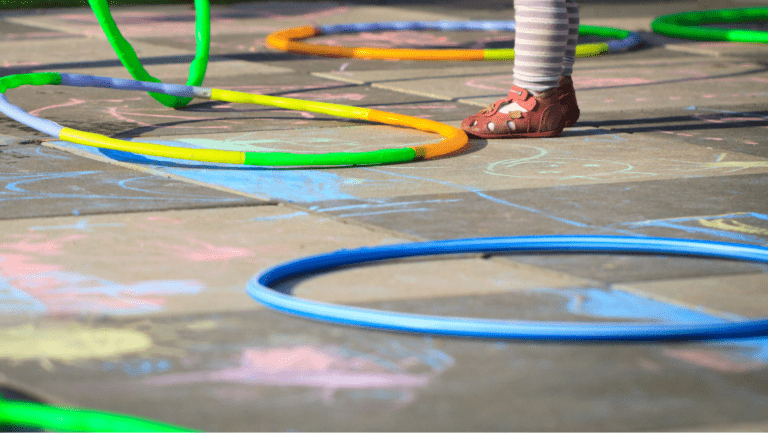
Level 1 - Beginner
The first level of musical hula hoops is very similar to the original musical chairs game. The difference, however, is that each hoop can hold more than one child. To start, spread out the hula hoops in a large, flat circle. When you play the music, children walk around the outside of the hoops. When the music stops everyone steps into a hoop (you don’t actually have to hula hoop with the hoop, it’s just acting as a container for the people). Make sure your whole body is inside the hoop (no flailing arms or legs). If you’re looking for some musical chairs songs, just scroll down to the bottom of this post for a list of our favorites.
Here’s an optional, fun extension idea for this level, too. If any hoop does not have exactly 2 people (or whatever number you decide in the beginning), then those groups are all out. Remove a hoop as needed and continue playing.
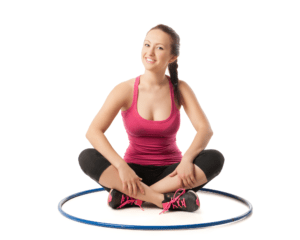
Level 2 - Advanced
Taking our twist on musical chairs up a notch to level two, we will now add new ways to enter the hoop, different numbers of people per hoop, and more. This is where you get to stretch those creativity muscles and have fun! For example, when the music stops, everyone must put only one foot in the hoop. Anyone who puts both feet in the hoop is then out.
Examples of new ways to enter the hoop:
- Only one foot allowed
- Only elbows
- One hand (on the ground, or above the hoop in the air)
- One leg floating above the hoop
- Sit in the hoop
- Both hands on the edge of the hoop
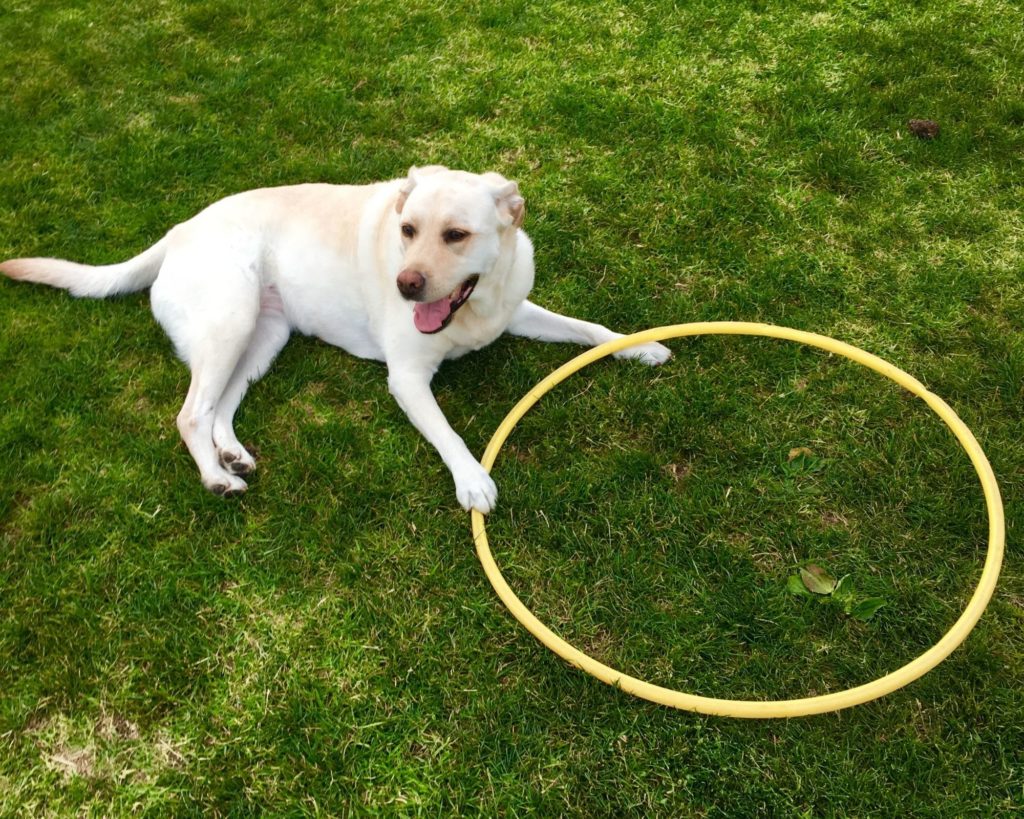
Once the players seem to have a grasp on level 2, you can further increase the challenge by switching the body part after each round, as opposed to only once per game. This requires an increased amount of focus and intentional listening during each round. Additionally, you can switch the direction that everyone walks around the hoops (clockwise for a few rounds, then counterclockwise, etc). Lastly, switch up the number of people allowed per hoop (I suggest only once per game). Usually, anywhere from 1-4 people per hoop works well, depending on the size of the hoops and size of the people.
Level 3 - Expert
After practicing level 1 and 2 of our twist on musical chairs, we are now ready to introduce new ways to travel around the hoops while the music is playing.
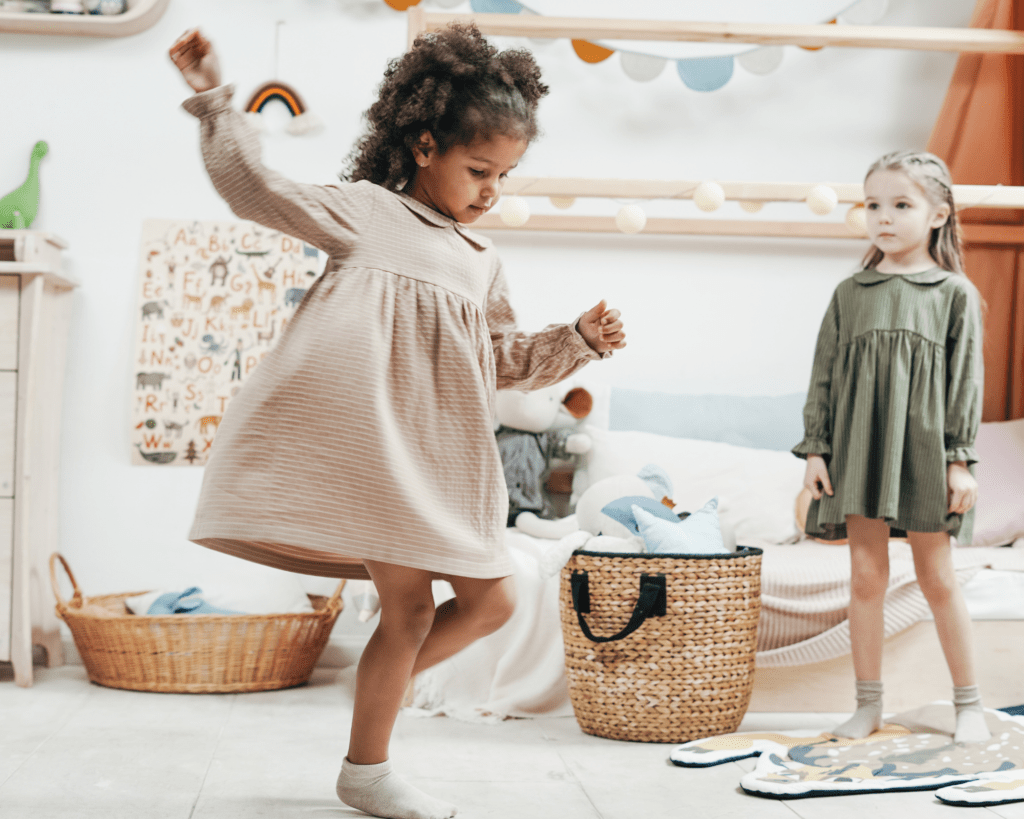
Examples of ways to travel
- Hop
- Glide/skate
- Side-step
- Walk backwards
- Walk like a robot
- Pretend you’re walking through honey or peanut butter
- Tiptoe
- Gallup
- Walk on your knees
Just like we discussed in level 2, once the players are comfortable moving in new ways around the hoops, challenge them to combine level 2 and 3 at the same time. For example, “glide around the hoops while the music is playing, and when the music stops, put one hand on the ground in the hoop”. For even more fun, switch up the number of people allowed per hoop, change the direction the group moves around the hoops, etc. Talk about a brain workout!

Level 4 - Master
That brings us to our final, master level: using a sound cue. In this final level, the players will switch directions (clockwise vs counterclockwise) when they hear a predetermined sound cue. For example, whenever you ding a triangle or hit a drum, everyone must rotate 180 degrees and continue walking around the hoops. Plus, if you’re looking for an extreme challenge (with older kids or adults), now you can combine all four levels at once! Oh yes, yes, yes, sign me up!
For instance, “side-step clockwise around the hoops while the music plays, and if you hear the triangle ding then side-step counterclockwise around the hoops, then, when the music stops you must sit in a hoop by yourself”. Does your brain hurt thinking about all that? That’s great! Build those neural pathways. As you can see, there’s an infinite number of variations to our musical hula hoops game. I encourage you to create your own, as well.

Bonus Level!
If you want to get really fancy with the last level (or, if you’re a music teacher looking for ways to include musical objectives with this game), then I have three more ideas for you. First, encourage the players to walk with the steady beat of the music (it helps if you use music samples around 120 bpm for this). Second, time your sound cue to line up with the form of the music (AB, ABA, etc). If you do this often enough, you could then challenge the players to switch directions at the correct time in the music, without your sound cue. Lastly, use music selections from a variety of cultural sources to encourage multicultural music appreciation and awareness.

Ways to include Players who are out
My final tip for musical hula hoops includes ideas for how to keep the players engaged with the game, even after they are “out”. One idea, is to have a few extra instruments available for people to play a steady beat during the music (they must stop when the music stops, too).
Another idea, although this one can get a bit tricky, is to invite whoever gets “out” to join your “helper team”. The helpers observe the other players to make sure they’re following the current directions and can give a gentle tap on the shoulder of anyone who isn’t following the directions. Again, use the “helpers” at your own discretion, and make sure everyone’s being respectful.

Favorite Songs for Musical Chairs/Hula Hoops
Here are a few music selections that will work well for our musical hula hoops game. All of these songs have an upbeat tempo, which is perfect for walking/sliding/galloping/etc during the game. (The links will take you to Youtube.)
- “Wellerman – Sea Shanty” by Nathan Evans
- “Life is a Highway” by Rascal Flatts
- “Can’t Stop The Feeling” by Justin Timberlake
- “Try Everything” by Shakira
- “Hoe Down” from Rodeo by Aaron Copland
- “Fossils” from Carnival of the Animals by Camille Saint-Saëns
- “Jupiter” from The Planets by Gustav Holst
- “Emerald” – Irish Celtic Music
In Conclusion
In summary, we took the classic game of musical chairs and twisted it all around into a multi-level, multi-directional musical hula hoops game! We explored regular musical hula hoops, then added new ways to enter the hoop, as well as, new ways to travel around the hoops, and lastly added a sound cue.
We also shared a few songs that would work well for musical hula hoops (or musical chairs, if you want to be plain and boring). The icing on the cake here would be to combine all the levels into one!
Now, I'd love to hear from you
Tell us in the comments below, which level do you want to try next? Do you have any more ideas to add to our hula hoop levels? Did you find a new favorite musical chairs song?

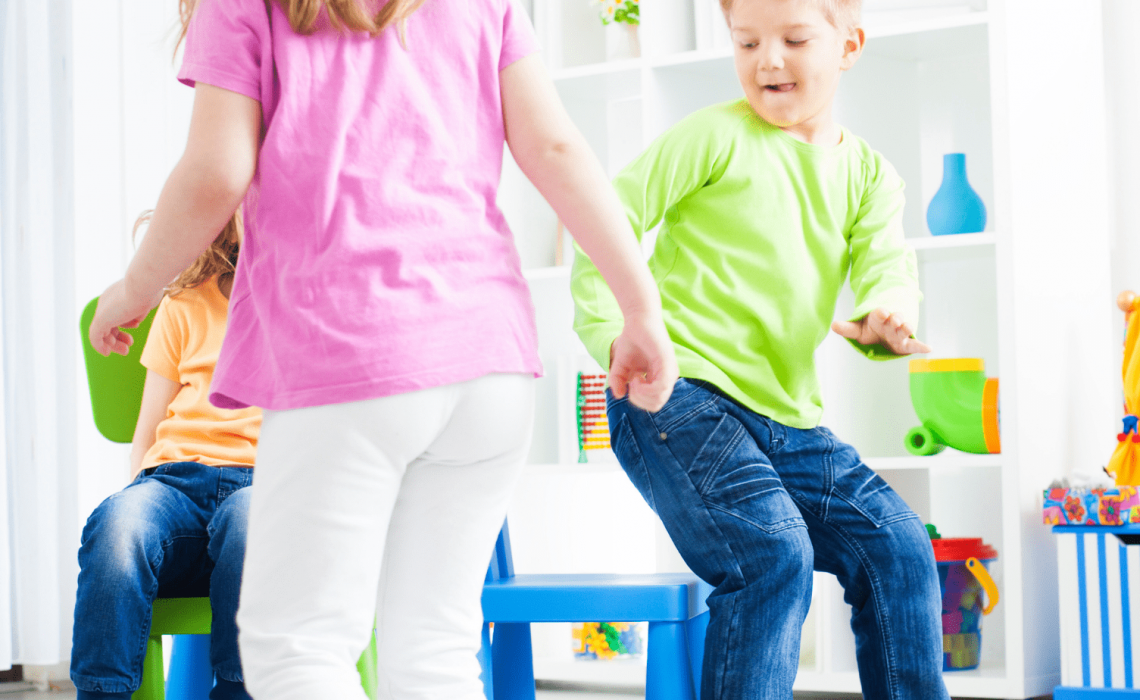

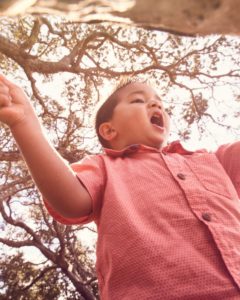
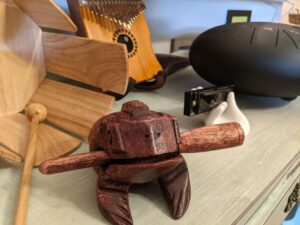
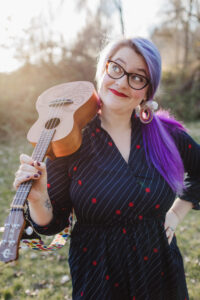



7 thoughts on “How to Play An Exciting, Clever Twist On The Classic Musical Chairs Game”
Pingback: 20 Games and Activities With Music for Kids - Teaching Expertise
Pingback: 20 Rainy Day Activities for Preschoolers - OhMyClassroom.com
Pingback: 20 Indoor Physical Activities for 3 5 Year Olds - OhMyClassroom.com
This is amazing, thanks so much for the variations, making standard musical chairs more enjoyable for the older ones too!
Glad you enjoyed it! Thanks for stopping by.
Question: do you use as many hoops as there are kids? And do you remove hoops each time to eliminate or is there not an elimination part of this? Thanks!
Hi Marcia! It depends how many kids are playing, if it’s just a few kids then yah I would give 1 hoop per kid, but if it’s a whole class then I would have the kids double up per hoop. Yep, then start taking away hoops!